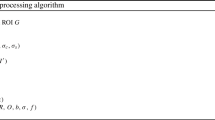Abstract
Finger vein recognition biometric system is one of the most current and accurate biometric technologies. Yet, early implementation of this technology is not widely used in real-time applications. In this work, a finger vein-embedded system based on Rasberry-Pi has been presented. In our process, we use four structural directional elements for smoothing finger veins ROIs. A Top-Hat and Bottom-Hat kernel filters are used to enhance the contrast quality of images. For feature extraction step, we used two approaches for the synthesis of attributes including the geometric and texture representations of venous prints. The first one is a Local Directional Code (LDC) descriptor that characterizes texture and directional information of finger vein print. The Improved Gaussian Matched Filter (IMPGMF) is used to extract the finger vein map that characterised geometric venous information. The proposed vision system presents an Error Equal Rate (EER) lower to 0.02 and Identification Rate (IR) higher to 98.99. Moreover, experimental results show that the designed system is fast enough to run the decision of finger vein verification. Performance results show the efficiency and robustness of our system.
Similar content being viewed by others
References
S. Prabhakar, S. Pankanti, and A. K. Jain, “Biometric recognition: Security and privacy concerns,” IEEE Sec. Priv. 1 (2), 33–42 (2003).
R. B. Trabelsi, I. K. Kallel, and D. Sellami Masmoudi, “Multimodal biometric system based palmprint and IRIS,” in Proc. 8th International Multi-Conference on Systems, Signals, and Devices (SSD 2011) (Sousse, Tunisia, 2011), pp. 1–5.
A. D. Masmoudi and D. Sellami Masmoudi, “Implementation of a fingerprint recognition system using LBP descriptor,” J. Test. Eval. 38 (3), 369–382 (2010).
R. B. Trabelsi, A. D. Masmoudi, and D. Sellami Masmoudi, “Hand vein recognition system with circular difference and statistical directional patterns based on an artificial neural network,” Multimedia Tools Appl. 75 (2), 687–707 (2016).
R. B. Trabelsi, A. D. Masmoudi, and D. Sellami Masmoudi, “A novel biometric system based hand vein recognition,” J. Test. Eval. 42 (4), 809–818 (2014).
B. T. Ton and R. N. J. Veldhuis, “A high quality finger vascular pattern dataset collected using a custom designed capturing device,” in Proc. IEEE International Conference on Biometrics (ICB 2013) (Madrid, 2013), pp. 1–5.
Y. Lu, S. J. Xie, et al., “An available database for the research of finger vein recognition”, in Proc. 2013 6th International Congress on Image and Signal Processing (CISP) (Hangzhou, 2013), pp. 410–415.
Y. Lu, S. J. Xie, S. Yoon, J. Yang, and D. S. Park, “Robust finger vein ROI localization based on flexible segmentation,” Sensors 13 (11), 14339–14366 (2013).
B. A. Rosdi, C. W. Shing, and S. A. Suandi, “Finger vein recognition using Local Line Binary Pattern,” Sensors 11 (12), 11357–11371 (2011).
X. Meng, G. Yang, Y. Yin, and R. Xiao, “Finger vein recognition based on local directional code,” Sensors 12 (11), 14937–14952 (2012).
B. Randa, D. M. Alima, and S. M. Dorra, Journal of Testing and Evaluation, 809–818 (2014).
M. Krid, D. Sellami Masmoudi, and M. Chtourou, “Hardware implementation of BFNN and RBFNN in FPGA technology: Quantization issues,” in Proc. 12th IEEE Int. Conf. on Electronics, Circuits, and Systems (ICECS 2005) (Gammarth, Tunisia, 2005), pp. 1–4.
R. B. Trabelsi, A. D. Masmoudi, and D. Sellami, Journal of Testing and Evaluation 42 (2013).
R. B. Trabelsi, A. D. Masmoudi, and D. Sellami, Journal Multimedia Tools and Applications 75, 687 (2016).
Author information
Authors and Affiliations
Corresponding author
Additional information
The article is published in the original.
Randa Boukhris Trabelsi was born in Sfax, Tunisia, in 1985. She received the B.S. degree in electronic from the Faculty of Sciences of Sfax, Tunisia in 2008, and the M.Sc. in electrical engineering from the National Engineering School of Sfax (ENIS), University of Sfax, Tunisia in 2010. Subsequently, she joined the Computers Imaging and Electronics Systems (CIELS) groups in Control and Energy Management Laboratory (CEM-Lab) to work towards her thesis. She received her PhD in 2014. Her researches include image processing theory and applications, computer science and imaging, real time image processing, human focused analysis. Currently, she is an associate professor at higher institute of computer science and multimedia of Sfax, Tunisia.
Alima Damak Masmoudi was born in Sfax, Tunisia, in 1981. She received her Engineering degree in Electrical Engineering since 2005 and MSc in Automatic-Computer-industrial Engineering since 2006 from the National Engineering School of Sfax, Tunisia. Subsequently, she joined the Computers Imaging and Electronics Systems (CIELS) groups in Control and Energy Management Laboratory (CEM-Lab) to work towards her thesis. She received her PhD in 2010 and she has been assistant Professor at Sfax Faculty of Sciences. Since 2014, she gets HdR degree. Currently, she is a professor at the same university. Her researches are focused on image processing, biometrics, medical image, and neural network implementations.
Dorra Sellami was born in Sfax, Tunisia in 1969. She received her engineers degree from Sfax National Engineering School in 1994 and has been awarded by the president of the republic of Tunisia. Subsequently she joined IMS. Lab at Bordeaux and received her Ph.D. degree in 1998 in electronics system design and she has been assistant Professor at Sfax National Engineering School from 1999. Since 2006, she gets HdR degree. She is actually a full professor. Her researches include neural and fuzzy based systems, evolutionary and genetic algorithms, pattern recognition, image and video processing, feature extraction, classification data fusion, it covers a large spectrum of applications: neural, fuzzy and neuro-fuzzy based image processing, biometry based personal identification and medical image processing for breast cancer automatic diagnosis.
Rights and permissions
About this article
Cite this article
Trabelsi, R.B., Masmoudi, A.D. & Sellami Masmoudi, D. A Real Time of an Automatic Finger Vein Recognition System. Pattern Recognit. Image Anal. 28, 430–438 (2018). https://doi.org/10.1134/S1054661818030173
Received:
Published:
Issue Date:
DOI: https://doi.org/10.1134/S1054661818030173




